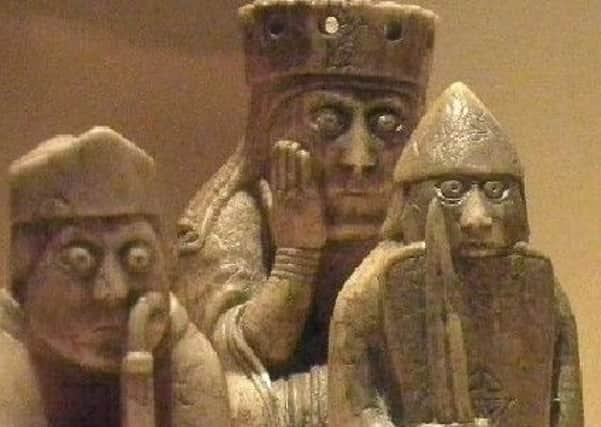When the Western Isles were the Southern Isles


The Lewis Chessmen are among the most iconic images of both the Isle of Lewis itself and the Norse heritage of the whole of the British Isles.
‘The Vikings in Lewis’ follows three main strands of evidence to illuminate the cultural context in which the Chessmen came to be on Lewis, and their legacy into the present: archaeological finds from the Scandinavian settlements on Lewis; the influence of the Old Norse language on place names; and material from Old Norse sagas and poetry that makes mention of Lewis, the Hebrides or Hebrideans.
Advertisement
Hide AdAdvertisement
Hide AdVikings first reached Scotland’s shores in the late eighth century, and their presence as raiders, settlers and traders is part of a history that culminated in four centuries of Norwegian rule in the western regions of the country.
The Scandinavians who settled and controlled the Hebrides until they were ceded to the Scottish crown in 1266 called the islands Suðreyjar (Southern Islands), reflecting their position in the Norse-settled islands relative to Orkney and Shetland.
However, despite the apparent density 1000 years ago of the Norse settlements across Lewis suggested by the etymology of current place-names, the archaeological evidence for Norse sites is relatively scarce.
There are two likely reasons for this under-representation.
First, in contrast to circular and cellular prehistoric structures, the ruins of rectilinear buildings typical of the Viking Age cannot be easily distinguished from later medieval and post-medieval structures.
Advertisement
Hide AdAdvertisement
Hide AdSecondly, it is likely that many of the farms and settlements established by early Norse settlers have survived to the present day, with the earliest phases obscured by subsequent activity.
To date, only two sites on Lewis have been securely identified as Viking settlements – the sites of Barvas/Barabhas and Bosta/Bostadh.
The name Bostadh almost certainly derives from the Old Norse bólstaðr (meaning cultivated and settled land, a farm) and attests to the likely presence of an early Norse settlement.
Excavation in 1996 revealed at least three semi-subterranean figure-of-eight-shaped structures, occupied between the sixth and ninth centuries, overlaid by a short-lived rectilinear structure and extensive midden (domestic waste dump) deposits, both tentatively dated to the Norse period.
Advertisement
Hide AdAdvertisement
Hide AdSteatite (also known assoapstone) bowl fragments excavated from near the rectangular structure confirm its likely Viking-Age date.
Steatite artefacts recovered from the pre-Norse contexts in the Western Isles are rare and confined to typologies of other stone artefacts typical of the Iron Age.
As for Barabhas, a small-scale excavation of one of the sites eroding from Barvas machair (a coastal sand landscape) confirmed it to be the remains of a Viking-Age settlement.
The remains of at least two sub-rectangular domestic structures with double-skinned stone-and-turf walls were exposed, alongside a rich midden deposit. Carbon-dating of the excavations indicate a date range between the late 10th and 14th centuries.
Advertisement
Hide AdAdvertisement
Hide AdMeanwhile, a distinctive Norse pottery style characteristic of the settlements in the Outer Hebrides was identified based on the assemblage from the Udal, North Uist. It has since been identified at a range of sites from Lewis in the north to Tiree in the south.
Pottery of this style was found at both the Barabhas and Bostadh excavations, and was recovered as a surface find near the eroding Viking-Age cemetery on Cnip headland, suggesting that there may be an undiscovered Viking settlement in the vicinity.
The range of forms of the Norse pottery does not appear to derive from any Hebridean precursor, suggesting that the incoming Norse settlers may have had a major impact on the manufacture of pottery. Interestingly, there are no obviousparallels for this new style of pottery in the Viking settlements of the Northern Isles, or in the Scandinavian homelands. The use of pottery in the Outer Hebrides can therefore be seen as a sign of continuity, albeit significantly modified to fit new cultural norms.
Although the Norse settlement of the Western Isles was once considered marginal in the context of the great Viking expansion throughout Europe, the excavations at such sites as Bosta and Barvas shed light on the daily lives of Norse farmers, the new agricultural practices they brought with them and the continuity of use of certain technologies, such as pottery.
Advertisement
Hide AdAdvertisement
Hide AdThis continuity is indicative of a blending of exisiting cultural traditions with those of Scandinavian settlers, and supports the integration of the two groups.
Next time in Back in The Day – The Scandinavian Place-names of Lewis: Naming the Landscape.